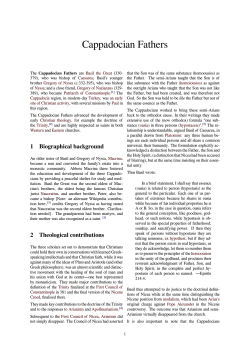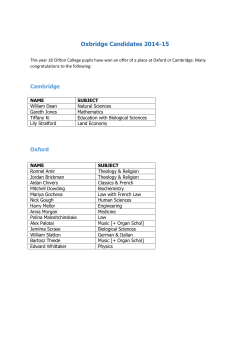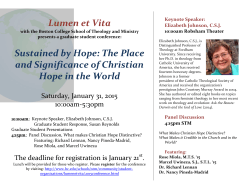
- Australian eJournal of Theology
Australian eJournal of Theology 22.1 (April, 2015) Book Review / Against Eunomius Against Eunomius St. Basil of Caesarea Translated by Mark DelCogliano and Andrew Radde-Gallwitz Washington, D.C.: The Catholic University of America Press, 2011. Series: The Fathers of the Church, volume 122. pp. xv, 207. ISBN 978-0813201221. US$34.95 hpk. asil wrote Against Eunomius in 364 in Cappadocia. It launched what has come to be called “Cappadocian theology”. But this is a misleading moniker if one forgets that each of the three Cappadocians—Basil of Caesarea, Gregory of Nazianzus, and Gregory of Nyssa—had a unique understanding of the Trinity. Mark DelCogliano, University of St. Thomas in Minnesota, and Andrew Radde-Gallwitz, Loyola University in Chicago, teach theology. They have produced the first English translation since Basil wrote Against Eunomius about 1650 years ago. As well as a user friendly translation of 115 pages, they have given us an extremely informative introduction that spreads across 75 pages. The first section evaluates the significance of Basil's book. First, the text uses homoousios only once; and the distinction between ousia (substance) and hypostasis (person) is strikingly absent. This means that he has produced an orthodox Trinitarian theology without using the Nicene inspired catchwords and formulae. Second, against Eunomius, Basil argues that theology isn't an attempt to know the unknowable essence of God. Instead, “it directs the theologian ever more fully to what humans do know of God, especially through Scripture.” Section two is an overview of Basil's life (329–379), with a focus on the stages of his intellectual and theological formation. Section three moves from this overview to a more detailed description of the historical context of Basil's book. It unfolds in three stages. First, there's the remote context: it takes us from the beginning of the controversy with Arius in 318, through the First Council of Nicaea in 325, to the councils that met in the 350's. Second, there's the proximate context: it takes us from the Council of Sirmium (357), through a number of councils, to the Council of Constantinople (381). The Apology of Eunomius, which got up Basil's nose, was written early in 360, either during or after a small council called by Constantius to ratify the decisions of the twin Councils of Ariminium and Seleucia which met in 359. Finally, there's the aftermath of the debate between Basil, who died in 379, and Eunomius, who died in 397. This was the period in which, first, Gregory of Nazianzus and, then, Gregory of Nyssa enriched and expanded Basil's Trinitarian theology. This section of the introduction is as good a summary of “the Arian controversy” as one can get. 59 AEJT 22.1 (April, 2015) Book Review / Against Eunomius The fourth section of the introduction is very useful for understanding what Basil wrote, and why he wrote it the way he did. It explains the genre of Against Eunomius: “it stands in a long tradition of polemical literature and needs to be interpreted as such.” This explains his sarcasm and ad hominem attacks on Eunomius. This polemical vitriol occurs in his construction of his reply to Eunomius as a judicial enquiry, with his readers as members of the jury. And so, “in line with judicial oratory ... sometimes Basil refers to Eunomius in the second person ... and directly addresses questions to him, as if he is examining him”; and sometimes he refers to him in the third person, as if he is speaking about him to a jury. These moves, and the language in which they are made, were perfectly acceptable to Basil's contemporaries. If they are ignored by us, we may miss his points, because we'll be making an anachronistic fuss about his “insults and sarcastic language.” The rest of the introduction gives us four things. A synopsis of Basil's major arguments against Eunomius; an introduction to his understanding of Scripture, as well as to ecclesiastical and philosophical authors who shaped his thinking; a glossary of his technical terminology; and comments on the text and its translation. It also has an extensive bibliography. Basil's book has three chapters: the first for understanding the Father; the second for understanding the Son; and the third for understanding the Spirit. And the criticism of Eunomius is as much about his hubristic theological method as about his objectionable idea that the Son and the Spirit are creatures. This means that it is an excellent introduction to how theology should be done, as well as to how the doctrine of the Trinity should be understood. The book that Mark DelCogliano and Andrew Radde-Gallwitz have published is worth acquiring for its introduction alone, and, in particular, for the section on how to read Basil's book. And reading the translation with the guidelines provided by DelCogliano and Radde-Gallwitz explains why “Basil is more concerned with proving Eunomius wrong” than with “presenting his own theology of the Trinity.” At the same time, a careful reading of his book could lead us to appreciate two ideas he refused to separate. It's not illogical to affirm “both God's unitary essence and the distinctive features that characterise Father, Son and Holy Spirit.” And, although it's impossible to know the essence of God, it's possible to do theology, because its subject matter is God's activity, rather than his essence. Reviewer: James Moulder is a retired business school academic and a student at Catholic Theological College in Melbourne, Australia. He regularly writes reviews for the AeJT. Email: plato@sims.com.au 60
© Copyright 2025















